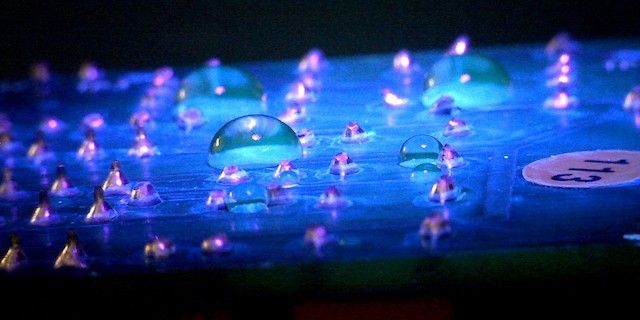Summary
Why are the fluoropolymer nano coatings the lowest cost conformal coatings?

This extensive range of conformal coatings are based upon fluoropolymer technology. This means the coatings are hydrophobic ( they repel water) and oleophobic (they repel oil) when applied to the printed circuit board.
They are also extremely thin. So, masking is not required in nearly all cases when conformal coating circuit boards.
The use of nano conformal coatings has a huge impact on cost of manufacture and it generally produces the lowest cost for production of all conformal coating materials.

Why select a nano conformal coating?
Why select a nano conformal coating?
The nano coatings do a different job to the traditional liquid conformal coatings.
What they do is effectively change the surface energy of the substrate they are applied to.
This change in surface energy makes it harder for liquids like water and oils to wet the surface and cause corrosion etc.

They are also ultra thin in nature. Typically, they are applied at 01.-2µm in thickness.
This means that generally you do not need to mask a circuit board with a nano coating. The film is so thin that the coating has no resistance when the connector parts are joined together.
How is a nano conformal coating applied?
Since no masking is applied or required then the process time is extremely low. In fact, the only process time is the application process.
Since no masking is applied or required then the process time is extremely low. In fact, the only process time is the application process.
The simplest method of application for the no mask conformal coating is to dip the whole board into the material. Dipping multiple boards at one time means process time is also extremely low.
Once the board is withdrawn and the excess material is drained then the coating dries extremely quickly and the board is coated.
This means the process time is extremely short. Typical process times can be less than 30s.
This means that the longest time is loading and unloading the boards for the application process.
Can the nano conformal coating replace a traditional conformal coating?

Can the nano conformal coating replace a traditional conformal coating?
This depends on what you want the coating to do and how the circuit is handled.
Since the coating is ultra thin it does not have the same resistance to handling like a traditional coating. So, if you intend to handle the board a lot then it may not be suitable.
However, if you can minimise the handling the board then the fluoropolymer coating may be suitable for your process.
Also, if you have high breakdown voltages on the board the FC coating may not give you the same level of protection. So, you really need to test the technology to suit your process.
However, if you want a coating that repels oil and water then a fluoropolymer nano coating could be ideal.

Where are nano coatings being used?
- Circuit boards
- Mobile phones
- Tablets
- Automotive parts (gears, rotors, pistons)
- Commercial bake-ware
- Filters, filter housing
- Glassware, labware
- Machine parts/components
- Printing equipment
- Sintered metal parts
- Catheters, guidewires
- Fasteners
- Screen, mesh (metal/synthetic)
- Filter media (cloth, synthetic)
- O-rings, gaskets, seals
- Silicone rubber
- Solenoid, springs, coils
How much does the nano coating process cost?
What is a fluoropolymer coating?
Why are fluoropolymer coatings used?

- Being highly hydrophobic (water repellent)
- Having a high moisture barrier
- Being highly oleophobic (oil repellent)
- Having a high chemical resistance
- Having a high lubricity
- Having high dielectric properties
- Suitable for sterilization
- Providing high corrosion resistance
- Providing good abrasion / wear resistance
What sectors are fluoropolymers being used?
- Aviation
- Aerospace
- Defense
- Automotive
- Industrial
- Oil & gas
- Electronics
- Medical/pharmaceutical
- Optics
- Telecommunications
- White goods/commercial
What are the five key differences between a fluoropolymer coating and a conformal coating?
- Hydrophobic properties. A fluoropolymer coating is generally hydrophobic in nature. It repels water when the water is on the surface of the coating. A traditional conformal coating is not hydrophobic.
- Extremely thin coating. The fluoropolymer coating is normally applied a lot thinner than a typical liquid conformal coating. Typically <1-2um compared to 25-75um for a traditional conformal coating. This is due to its superior performance when repels liquids.
- No masking. Due to the extremely thin fluoropolymer coating applied (<1-2um), the components that normally require protecting (connectors, switches etc) from the insulating liquid conformal coating may not need to be masked for the fluoropolymer. This is because when the mating parts are joined they can scrape through the coating. The circuit board can be completely submerged in the liquid with no masking applied without fear of damaging the connections.
- Simple process. No masking means an extremely fast application process compared to traditional coatings.
- Fast drying. Due to the thin nature of the fluoropolymer coating and the high flash point of the solvents normally used the coating dries extremely quickly.
Contact us
Call us on +44 (0) 1226 249019, email your requirements on sales@schservices.com, contact our distributors direct or complete the details in the contact form.
